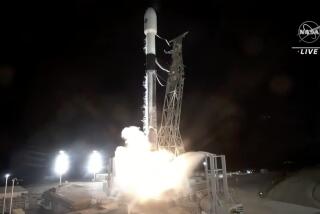El Toro Airport Foes Unveil Village Proposal
- Share via
IRVINE — Opponents of a commercial airport at El Toro Marine Corps Air Station on Monday unveiled their proposal to instead develop a sprawling mini-metropolis at the surplus military base.
The plan has as its centerpiece a 360-acre central park with botanical gardens in addition to nearly 500 acres for homes, a 76-acre stadium and about 1,300 acres for a business and technology center that would include a university campus. Planners estimate that the total cost of building the project by 2020 would be $683 million.
“Today we are launching a new vision for Orange County,” said Supervisor Tom Wilson, who is against the highly controversial commercial airport at the 4,700-acre base. “For those who are worried about commercial and cargo jets flying over their heads, this plan is bigger and better than an airport. . . . I think this plan will open a lot of eyes in the county.”
But the nonaviation plan has little chance of becoming reality unless Measure A, which changed the county’s General Plan in 1994 to permit a commercial airport at El Toro, is overturned by another countywide ballot measure. No such measure is in the works as yet.
The El Toro Reuse Planning Authority, the agency charged by the county Board of Supervisors with putting together a nonaviation alternative for the base, said its concept would generate about 110,000 countywide jobs--including about 45,000 on-site--and result in about $8.2 million in net annual revenue for the county by 2020.
With the Marines expected to leave in July 1999, this is a critical year for deciding the base’s future. In April, the county will present four preliminary schemes for a commercial airport, a contentious plan that is opposed by nearly all of south Orange County, where residents fear more noise, heavier traffic and lower property values.
Another major obstacle to the nonaviation plan is that anti-airport Supervisors Wilson and Todd Spitzer are in the minority on the board, which is in charge of the reuse process for the military base.
Political observers say it would take an upset in this year’s supervisorial elections to tilt the board’s balance and give the plan a chance of being implemented.
“This plan has a lot of elements that would be popular with Orange County residents,” said Mark Baldassare, a professor of urban planning at UC Irvine who has conducted several polls on the airport issue.
He noted that a majority of voters both approved Measure A and later defeated another initiative that would have overturned Measure A.
*
“The political reality,” Baldassare said, “is that the county has had two votes on the issue and the Board of Supervisors has moved ahead with a plan that calls for the predominant use of the land to be an airport. Unless there is a political change, it’s unlikely that this will ever get off the drawing board.”
Airport foes are keenly aware of the uphill political battle they must wage.
To increase public awareness about the plan, the El Toro authority plans to show the proposal to supervisors today and visit northern and central county cities in an attempt to sway residents.
But the roadshow will not be enough, airport opponents concede.
“There are two seats open on the Board of Supervisors,” said Irvine Mayor Christina L. Shea, referring to Supervisor Jim Silva and outgoing Supervisor William G. Steiner’s open seats in predominantly pro-airport districts. “We need to do everything we can to get one more vote on that board and turn around the direction of Orange County.”
Besides the political considerations, airport supporters argue that the nonaviation plan is not economically viable, pointing out that the county already has major retail areas, parks and a stadium in Anaheim that was recently renovated.
“Just in the city of Irvine, in the city’s General Plan, there is an excess of 131.5 million square feet of office/industrial/institution space,” said Newport Beach Mayor Thomas C. Edwards, a staunch airport supporter. “That is larger than downtown Los Angeles and Century City combined. And now they are going to add another 12 million square feet of office space? I do not believe it is sustainable. It’s Fantasyland South.”
Esmael Adibi, director of the Anderson Center for Economic Research at Chapman University, said the key will be finding the financial backing to develop the plan.
“It’s difficult for people to tell the market what is going to be there,” Adibi said. “In any venture of this size, the question would be who would pay for the risk? If the private sector builds residential units, there would be a positive impact. The question would be who is going to put up the money up front to start this?”
Anti-airport planners say their research, based on county projections for growth, supports their ideas.
Orange County’s population has increased by 46,000 annually since 1990 and is expected to reach a total of 379,000 people by 2020, with 43% of the growth from Tustin to San Clemente.
Housing needs have not kept up with the burgeoning population, say the authority’s planners, who maintain the plan to build 6,000 single-family, retirement and apartment units in the area will help alleviate that need.
*
In addition, the county’s employment growth rates have averaged 1.7% from 1990 to 1997, and future employment growth rates are expected to average 2.3% annually through 2020. Nearly 36% of those new jobs are expected to be in South County, planners say.
“We have looked very carefully at these growth numbers and what the needs are and we have looked very carefully at the available land to identify if this will be supported,” said Richard Gollis, principal of the Concord Group, which did the economic and market analysis of the plan. “The project itself generates demand and will provide employment opportunities for South County.”
*
The ambitious plan, which cost about $1 million to craft, calls for the area to become an urban village in which residents could walk to the parks, restaurants and theaters. Traffic congestion would be eased by opening major arteries from the larger thoroughfares like the transportation corridor and the San Diego Freeway.
These costs of the nonaviation plan include buying the property from the federal government, ripping out the runways and building the infrastructure necessary to maintain the property, planners say.
None of the expenses would involve taxpayer money. Funding would come from bond sales, developer investments and assessment districts.
County officials say their airport plan will cost about $1.4 billion, with all of the money coming from airport revenue bonds and federal funding. The county projects revenue from both an airport and companion nonairport use at $6.1 million a year by 2020.
The plan to build an airport for 38 million passengers annually by 2020 would generate 143,000 countywide jobs with an average annual salary of $30,000, airport proponents say.
Despite the hurdles, airport opponents remain optimistic that when the public sees details of their plan, residents will be convinced it is the way to go.
Said Kathleen Blackburn, a member of the El Toro authority’s board and Laguna Beach councilwoman: “We will take this on the road and we will convince people that this is the better alternative.”
(BEGIN TEXT OF INFOBOX / INFOGRAPHIC)
El Toro Alternative
Newly proposed nonaviation plans for El Toro Marine Corps Air Station focus on revitalizing the base into a business, residential and entertainment hub. A look at the plan:
Source: El Toro Reuse Plan; Researched by JANICE L. JONES / Los Angeles Times
More to Read
Sign up for Essential California
The most important California stories and recommendations in your inbox every morning.
You may occasionally receive promotional content from the Los Angeles Times.










